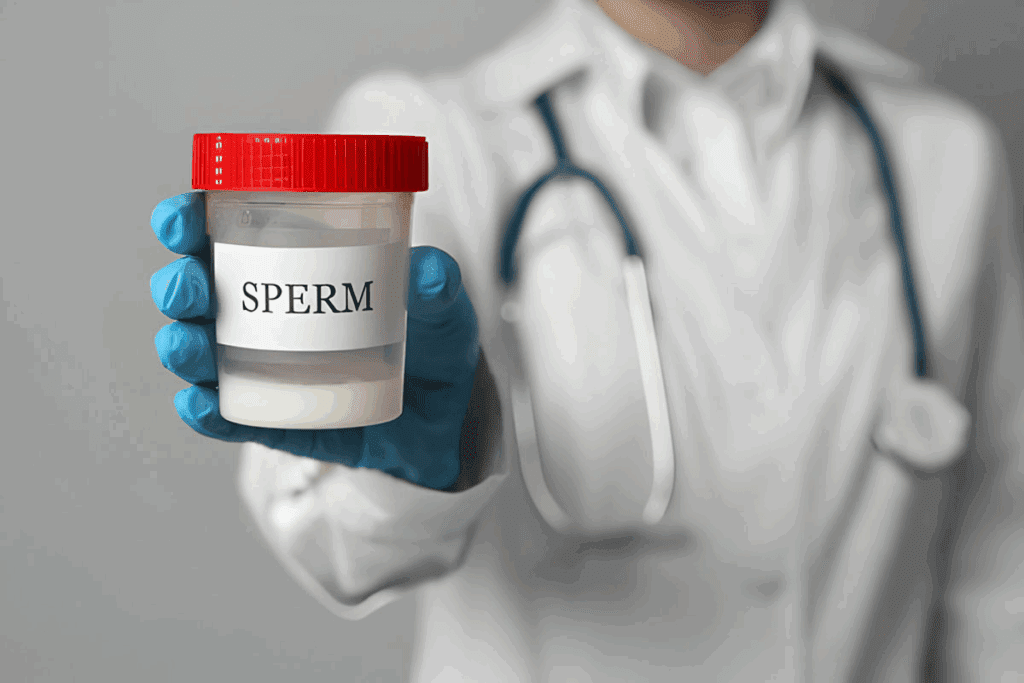Last Updated on November 25, 2025 by Ugurkan Demir

Get a complete analysis of what is a normal sperm count. Understand the accepted ranges for male fertility and when to seek medical advice.
Semen analysis is key for checking male fertility. It looks at a semen sample for sperm count, motility, and shape. A normal test shows at least 15 million sperm per milliliter, 40% motility, and 4% normal shape.
Bad semen analysis results can mean fertility problems. Low sperm count or poor motility can lower fertility a lot. Sometimes, it finds other issues like antibodies or infections.
Getting accurate results needs proper sample collection and handling. This means not ejaculating for 2-3 days before and giving a fresh sample.
Knowing about semen analysis helps tackle fertility issues. It guides people in making smart choices about their reproductive health.

Understanding male fertility is complex. It involves many factors, including semen analysis. This tool helps doctors see semen quality and find issues that might stop a man from getting pregnant.
Semen analysis is a key test for semen quality. It looks at sperm count, how well they move, and their shape. This helps doctors check semen health.
Semen analysis is key for checking male fertility. It helps doctors find problems that might stop a man from getting his partner pregnant.
<p>By looking at the semen, doctors can spot any problems that might affect fertility.</p>

Semen analysis is key for checking male fertility. It looks at a semen sample to see how well a man can reproduce.
Men are told to not ejaculate for 2 to 5 days before the test. This helps get a true sample of their sperm. Keeping clean is also important to avoid messing up the sample.
The sample is collected by masturbation into a clean container given by the doctor. It’s then checked for sperm count, how well they move, and their shape.
The test results can tell a lot about fertility. If the results are off, it might mean low sperm count or other issues. These problems can often be fixed with the right treatment.
It’s key to understand what a semen analysis shows about male fertility. These results tell us a lot about the semen’s quality and amount. This info is vital for figuring out fertility.
A semen analysis that shows normal results means a man might be fertile. The World Health Organization (WHO) sets standards for what’s considered normal. These standards include:
These values help figure out if a man might be fertile. But, having values below these doesn’t mean a man can’t have kids. It might just mean he needs more tests or treatment.
Many things can change how good semen is. For example, some chemicals and toxins can hurt sperm count and how well they move. Also, smoking and drinking too much alcohol can make semen quality worse.
Knowing about these factors is important for those trying to have a baby. By making smart choices and getting medical help when needed, people can improve their semen quality.
Our lifestyle choices greatly affect our reproductive health. The choices we make every day can either help or hurt our fertility. We will look at how different lifestyle aspects impact sperm count and male fertility.
Diet and Nutrition: Eating a balanced diet full of antioxidants, vitamins, and minerals is key for healthy sperm. Foods like berries and leafy greens can boost sperm quality. Make sure to eat a variety of fruits, vegetables, whole grains, and lean proteins.
Physical Activity: Exercise regularly to improve your health and reduce stress, which can help fertility. But too much exercise can be bad. Aim for a balanced routine with moderate physical activity.
Stress and Mental Health: Too much stress can harm fertility. Try stress-reducing activities like meditation, yoga, or deep breathing to help manage stress and support reproductive health.
Substance Use: Smoking, drinking too much alcohol, and using drugs can all hurt sperm count and quality. Try to limit or avoid these substances to boost fertility.
Environmental Factors: Some environmental toxins and pollutants can harm sperm health. Try to reduce exposure to harmful chemicals and keep your environment healthy.
By making smart lifestyle choices, you can support your reproductive health and improve fertility. Adopt a holistic approach that includes a balanced diet, regular exercise, stress management, and avoiding harmful substances.
Certain medical conditions can make it hard to get pregnant by affecting sperm quality. We know that health issues can impact how well you can have kids. It’s key to understand these conditions to boost fertility.
Some medical conditions that can affect fertility include:
Knowing how these conditions affect fertility is vital. We’ve made a table to show how different medical conditions can impact male fertility.
| Medical Condition | Impact on Sperm Production | Impact on Sperm Motility | Impact on Sperm Morphology |
| Varicocele | Reduced sperm count | Decreased motility | Abnormal morphology |
| Hormonal Imbalance | Low sperm count | Poor motility | Normal or abnormal |
| Infections | Variable impact | Reduced motility | Normal or abnormal |
| Ejaculation Disorders | No direct impact | No direct impact | No direct impact |
It’s vital for those facing fertility issues to see a healthcare professional. They can help diagnose and manage any underlying medical conditions. By tackling these conditions, we can improve fertility and help people reach their reproductive goals.
Keeping a balanced lifestyle and knowing what affects fertility can help. Regular health check-ups, a nutritious diet, and managing stress are key. These steps can boost your chances of having a baby.
A normal sperm count is at least 20 million sperm per milliliter of semen.
A semen analysis involves collecting a sample and examining it under a microscope. It checks the quantity, quality, and motility of the sperm.
Sperm motility is key for moving through the female reproductive tract. A motility of at least 50% is normal.
A normal semen volume is between 1.5 and 5 milliliters.
Improving fertility involves a healthy lifestyle. This includes a balanced diet, regular exercise, and avoiding smoking and excessive alcohol.
Low sperm count can stem from hormonal imbalances, disorders, and certain medical conditions.
When looking at sperm analysis results, it’s key to know the different parameters. These include sperm count, motility, and morphology.
A normal sperm count is at least 20 million sperm per milliliter of semen.
Sperm motility is about moving properly. A motility of at least 50% is normal.
Sperm morphology is about shape and structure. Abnormal morphology can impact fertility.
Understanding these parameters helps individuals grasp their sperm analysis results. It also guides them in improving their fertility.
National Center for Biotechnology Information. (2025). What Is a Normal Sperm Count Complete Analysis. Retrieved from https://www.ncbi.nlm.nih.gov/pmc/articles/PMC8706130/
Subscribe to our e-newsletter to stay informed about the latest innovations in the world of health and exclusive offers!